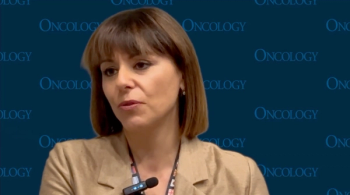
Oncology NEWS International
- Oncology NEWS International Vol 14 No 2
- Volume 14
- Issue 2
Follow-up Data Support Use of Stanford V Regimen for HD
SAN DIEGO, California-One in four Hodgkin’s disease (HD) patients has become a parent since participating in prospective trials of an experimental first-line regimen, known as Stanford V, designed to reduce toxicity from chemotherapy and radiotherapy.
SAN DIEGO, CaliforniaOne in four Hodgkin’s disease (HD) patients has become a parent since participating in prospective trials of an experimental first-line regimen, known as Stanford V, designed to reduce toxicity from chemotherapy and radiotherapy.
"Patients have retained their fertility, and they have not had short-term effects that relate to lung toxicity or heart disease," Sandra J. Horning, MD, of the Stanford Cancer Center, Stanford University, said at the 46th Annual Meeting of the American Society of Hematology (abstract 308).
Dr. Horning reported that efficacy and short-term effects data from studies conducted from May 1989 to May 2001 support an ongoing phase III Intergroup trial (E2496) of the regimen.
"Despite reductions in the duration of therapy and also the volume and dose with Stanford V, the cure rates in our experience have actually improved," Dr. Horning told ONI after a press briefing. "And with those reductions, the anticipation is that we will see fewer late effects in a 10- to 20-year period."
The Stanford V regimen involves lower cumulative doses of the chemotherapy drugs doxorubicin, vinblastine, nitrogen mustard, vincristine, bleomycin, etoposide, and prednisone. It also replaces wide-field radiation with narrow tumor-focused fields at lower doses.
Three Studies
One study delivered 8 weeks of Stan-ford V chemotherapy and 30 Gy of radiation to 87 patients with favorable stage I-IIA disease. In two other studies, the regimen was 12 weeks of Stanford V chemotherapy and 36 Gy of radiation for 61 patients with bulky stage I-II disease and 108 with stage III-IV disease.
Neutropenia was the most common major acute toxicity, Dr. Horning said. Grade 3-4 neutropenia occurred in 60% of patients at the lowest dose used and in 83% of those who received the more rigorous regimen. Except for five cases of grade 3 sensory neuropathy and 12 cases of grade 3-4 constipation, she described the side effects as mild.
As is typical of Hodgkin’s disease, the population was young with a median age of 29 years. Average follow-up ranged from 5.7 years for the early-stage patients to 6.9 years for those with more advanced disease.
The investigators gave 8-year estimates of 97.3% for disease-specific survival, 95% for overall survival, and 90.5% for freedom from progression for the combined trials’ population.
She reported that 24 patients have had disease progression so far, but second-line therapy was successful in 66%. Eleven deaths occurred, including six from Hodgkin’s disease, one from complications of second-line transplantation, and one from lung cancer. An international prognostic score (IPS) of 4 or higher predicted the worst outcomes, according to Dr. Horning’s data.
No cases of secondary leukemia or myelodysplastic syndrome were reported. Although some secondary solid tumors have occurred, Dr. Horning said that more time is needed to determine the secondary solid cancer rate.
Among 245 surviving patients, she said 66 babies have been born subsequent to the Stanford V treatment and four more "were in the incubator." (Conceptions from pretreatment semen or embryo cryopreservation were excluded). Men and women conceived in equal numbers, she said.
Articles in this issue
almost 21 years ago
FDA Approves Abraxane for Metastatic Breast Canceralmost 21 years ago
FEC Followed by Docetaxel Improves Breast Ca Outcomesalmost 21 years ago
Randomized Trial Validates Advantages of SNBalmost 21 years ago
70-Gene Signature Predicts Time to Breast Ca Metastasesalmost 21 years ago
Imaging Guides Efforts to Improve the Therapeutic Ratioalmost 21 years ago
PET/CT Is Fast Reshaping Cancer Management,Drawing Two Specialties Togetheralmost 21 years ago
New 5D Model May Predict Motion of Lung Tumors During Respirationalmost 21 years ago
PET/CT Outperforms PET or CT Alone in Imaging Non–Small-Cell Lung CancerNewsletter
Stay up to date on recent advances in the multidisciplinary approach to cancer.
















































































